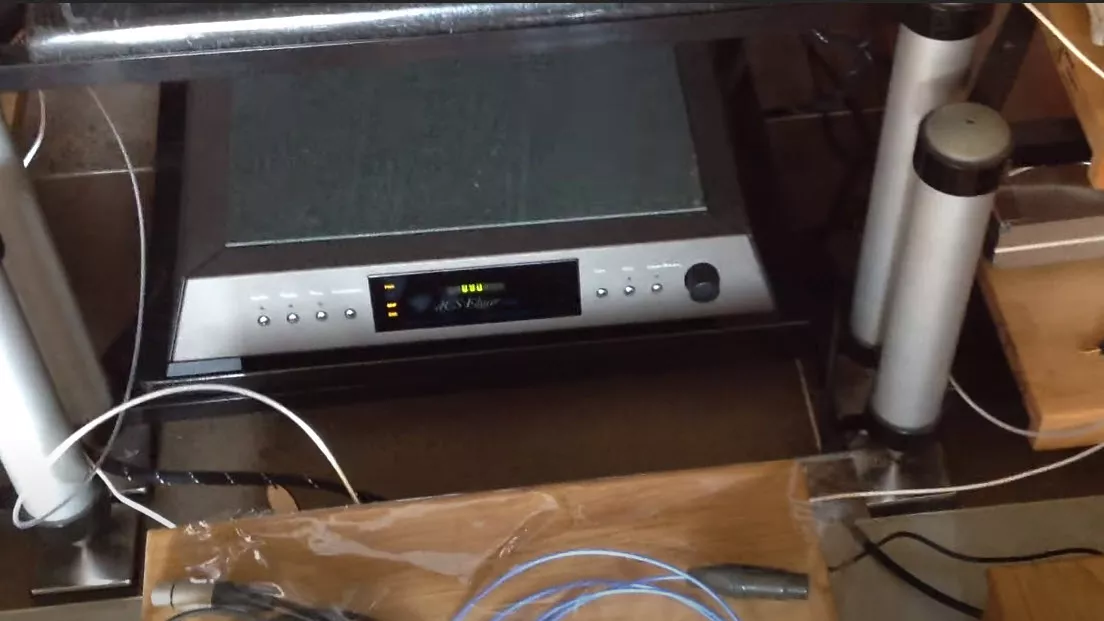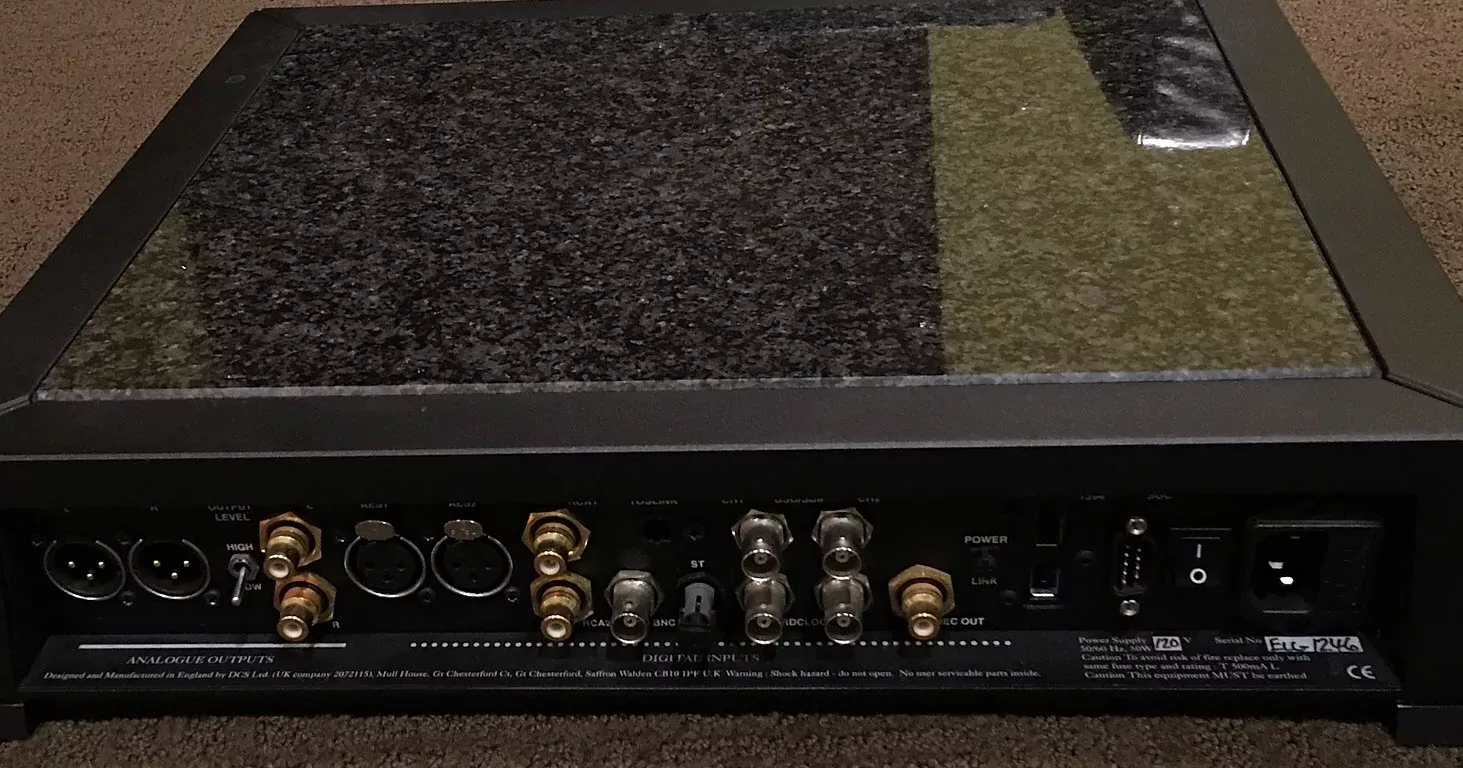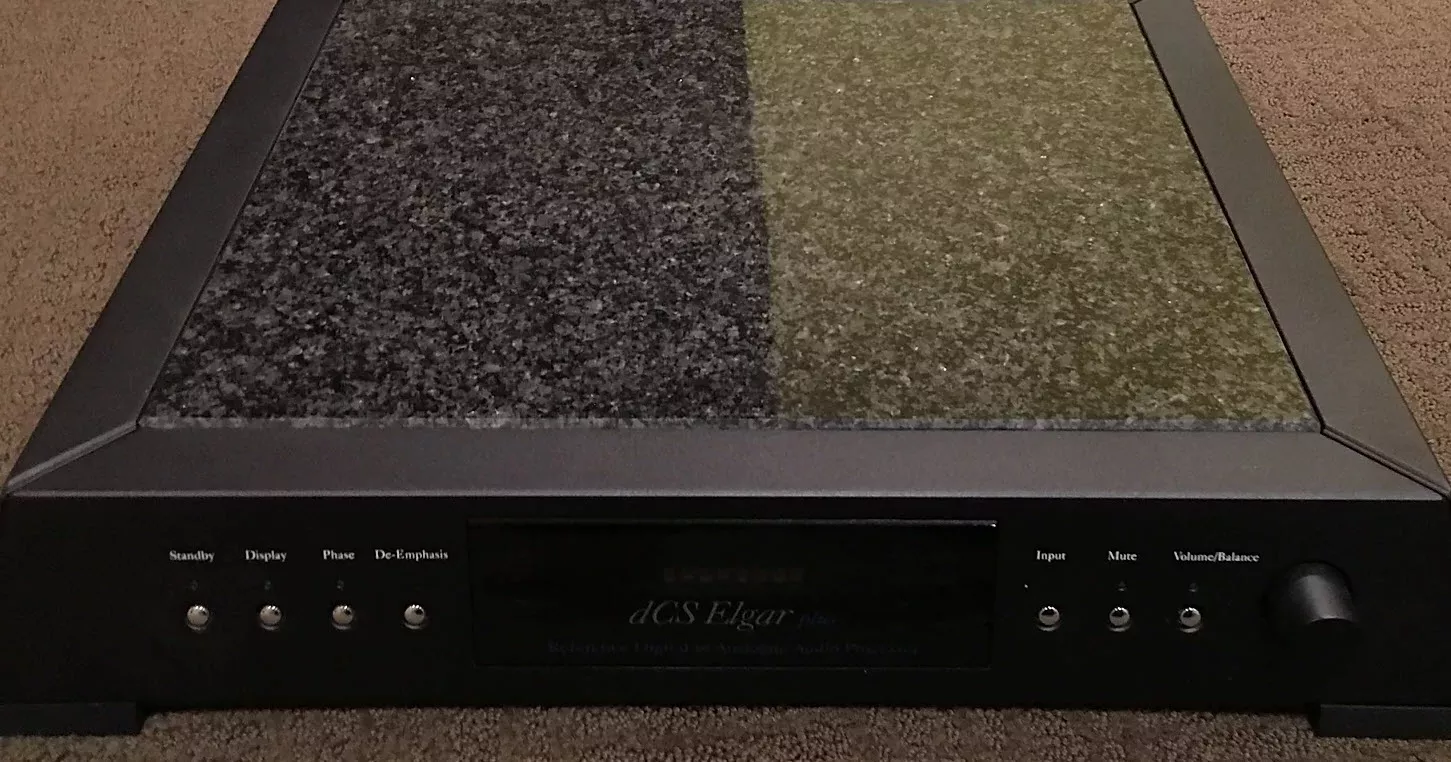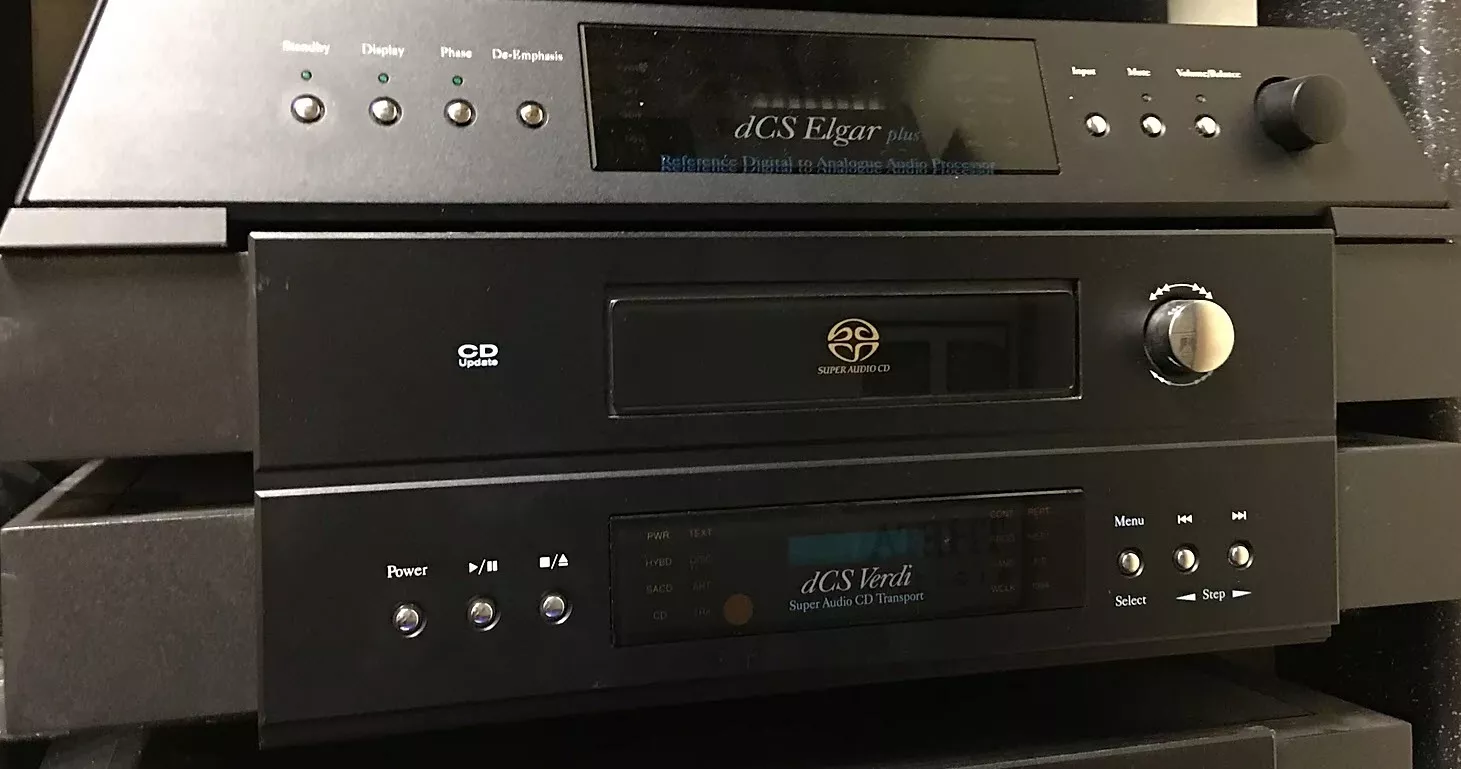The dCS Elgar Plus DAC
Elgar Plus is still one of the most advanced DA converters (1) or DAC (3) released for domestic use (2). This is an improved version of the legendary dCS Elgar transducer (5). The original dCS Elgar, released in 1996, became famous as the world’s first DAC with 24/96 parameters (4).

DCS ELGAR PLUS STANDALONE CONNECTION
The dCS Elgar Plus DAC appeared in 2000 as an upgrade to the dCS Elgar DAC, a digital-to-analog converter. It was the first DAC device with the capability to play 24bit/96kHz audio files. Later it processed 192kHz files as well.
Furthermore, it was also upgraded to play DSD thanks to the IEEE1394, which was the standard for transferring data streams of encrypted DSD (direct stream digital) at the time.
High-end dCS Elgar Plus Digital to Analog Converter. In 2002 retail was $ 19,000.
In 1998, the Elgar was improved, becoming the first DAC with parameters 24/192. And in 2000, we equipped it with means for receiving DSD format signals from professional digital DSD sources, and Elgar Plus became the first audiophile digital converter for DSD.
In 2001, the IEEE1394 digital interface was added to the standard equipment of the device. Sony planned to use this interface to exchange DSD signals between its devices, i.e. It was the standard consumer interface until superseded by other technologies.
dCS Elgar Plus works well in a stack with other dSC devices: Elgar Plus uses IEEE1394 to receive DSD signals from SACD/CD dCS Verdi vehicles when playing back recordings from the high-resolution SACD layer, as well as Purcell dCS signals when upsampling a CD signal to DSD format.

In 2003, Easy Play software was released for this popular device.
The advanced technologies used in Elgar Plus provide the user with a number of additional features, besides those provided by the ordinary audiophile DAC. This opens up greater freedom of choice for configuration options and utilization in specific systems.
Ring DACs is the central part of Elgar Plus is the patented dCS ring DAC. This device of a peculiar architecture provides 5-bit 64-fold oversampling. 64-fold oversampling means that the actual flow rate will be 2822 or 3072 million samples per second at sampling frequencies of 44.1 kHz or 48 kHz, respectively. This allows the use of very soft and therefore transparent analog output filters.
The ring DAC does not have the limitations inherent in single- and multi-bit converters of a traditional design, which are the basis of most other DACs. This DAC is the development of the experience that we have gained by developing an ADC for fighter radars. The quality of the ADC is the main factor limiting the effectiveness of the radar. Only the best instruments are applicable here. The slightest compromise can lead to disaster.
To better understand the advantages of the ring DACs, let’s briefly review the advantages and disadvantages of traditional single-digit DACs and multi-digit binary weighing DACs.
The advantage of single-bit systems is good linearity, but due to the fact that the DAC output switches between two levels with a very high frequency, even small clock errors create noise and distortion. In addition, the high quantization noise inherent in them does not significantly reduce the level of intrinsic noise.

Traditional multi-bit DACs differ from single-bit DACs in the lower levels of distortion and noise. Their weak point is a set of current sources, which is implemented in these DACs on resistor chains. If the current “I” in the 16-bit converter corresponds to the highest discharge, then i/2 corresponds to the next, then i/4, etc., and the lowest discharge corresponds to current i/65536. It is very difficult to make resistors with such accuracy, moreover, their resistance changes with time, and under the influence of temperature. As the converter capacity increases, the problem worsens.
Therefore, the usual multi-bit architecture is characterized by poor linearity in the lower digits, i.e. does not provide a satisfactory resolution of low-level signals. Ring DAC dSC – five-digit segmented converter. This architecture eliminates the problems characteristic for setting extremely low currents through resistor circuits in binary weighing converters.
To eliminate the residual error of current sources, a special technique is used. The sampling frequency of this DAC is lower than that of single-bit converters, which eliminates the problems associated with small deviations of the high clock frequency. The accuracy of dCS ring DACs does not decrease with time or with temperature fluctuations. Unlike some other DACs, it does not require a long and expensive setup or special selection.
The dCS ring DAC always works perfectly. which eliminates the problems associated with small deviations of the high clock frequency. The accuracy of dCS ring DACs does not decrease with time or with temperature fluctuations.
And most importantly, the dCS ring DAC has exceptional linearity over the entire dynamic range. Linearity is a key characteristic of a/c converters, it is curious that it is very rarely given in their specifications. Usually, it is reported that the converter is 24 bit, but this only means that the DAC is capable of receiving codes with a length of 24 bits. This does not imply the ability to resolve code in all 24 bits. But Elgar Plus is capable of this.
Other DAC Options And The dCS Elgar Plus DAC
The dCS Elgar Plus is a much better DAC than the Schiit Modi 3. However, the latter costs only a hundred dollars. We went through the Schiit Modi 3 when studying the architecture of a Schiit stack.
If you own a Devialet Gold or Silver Phantom, you should prefer using the Devialet DAC. They are located inside the mainboard.
The analog inputs just get converted through ADC to a digital signal and then converted back for output. As good as the ADC is in Devialet, fewer conversions are always better.
The Devialet converts everything analog input into it to digital and then back to analog so the DAC itself cannot be ‘bypassed’ so it sounds most logical that the USB input isn’t well implemented or that it isn’t playing nice with the Antipodes. Reviewers state that they got better sound WiFi streaming to it (vs Macbook pro via USB or similar), but that they had dropouts,
Placement Of The Elgar Plus In A dCS Stack
The dCS stack I refer here is composed by the dCS Elgar Plus + dCS Verdi + dCS Purcell. The price of the stack is around 32,000 dollars. Sitting atop an equipment rack, the triple dCS stack casts an impressive visual spell. The pieces can also be set on separate shelves, of course. It is much better than the Schiit stack we have already reviewed in this article, but also much more expensive.

When you’re listening to CDs, you can bypass the Purcell DDC and send the Verdi’s 16-bit/44.1kHz output directly to the Elgar Plus DAC, or you can customize the Purcell and choose your upsampling rate. Without getting hyper-specific about what I heard, the Verdi-Elgar Plus’s rendering of 16/44.1 was as good as I’ve heard the format, with close to the same level of transparency, focus, and spatiality as I heard upsampling through the Purcell. What the Purcell seemed to improve—especially in 176.4kHz or DSD mode—was image delicacy, dimensionality, and subtlety.
Despite their almost infinite possibilities of connection and playback, I recommend you to start with the most general settings. Otherwise, you might never get to listen to an entire piece of music as you experiment with various digital filters and upsampling options
So instead of playing around, start by placing a CD in the drawer mechanism and operate the device as you would with any CD player. When you hit “Play”, the Purcell’s (Purcell is part of the dCS stack) display shows “441-DSD” and the Elgar Plus’s display shows “Purcell.” This lets you know that the transport’s signal is feeding the Purcell, which is upsampling to DSD and feeding the Elgar Plus via the IEEE1394 connection.
Improvements From The Original Elgar
The Elgar Plus improves on the Elgar’s performance and operation by adding DSD decoding via FireWire or SDIF-2 interfaces and by allowing it to slave to a word clock or to act as a master clock. It also adds a digital output and an improved and extended menu system.
Because the Plus, like the original Elgar, can decode 24/96 and 24/192 data, you can connect a DVD-V player’s 24/96 bitstream (if available—many DVD players downconvert to 24/48) and decode DAD discs. Like all dCS DACs, the Elgar Plus uses the company’s proprietary Ring DACs for digital conversion.
Almost every other company making DACs and CD players uses off-the-shelf, chip-based DACs made by other companies, and that it was only because of dCS’s contracts with the UK military that the company could afford the R&D needed to design and build such precision devices in the first place. The Elgar Plus’s software-driven DSP is upgradeable via a CD player or, via a rear port, or a PC.
Cons: Volume controls
The volume control is in 0.5db increments. I would have liked 0.1db increments to gain precision. This is the only thing I can think of that is negative about this equipment. It costs a small fortune but delivers leading-edge performance for what you pay.
Specifications
- 24/192 – DSD D/A Converter
- Sample rates: 32, 44.1, 48, 88.2, 96, 176.4 & 192kS / s
- 24-bit resolution
- 8 digital inputs
- Sony DSD digital input via IEEE1394 interface
- weight: 12kg (26.5 lbs)
Conclusions
Nothing can help awfully recorded and/or digitized productions, so if you’re expecting the dCS combo to work miracles on DDD discs ca 1984, you’ll be disappointed.
This box produces the most lifelike sound I have ever heard from a stereo system. The “blat” of the horns, the ringing of a triangle, the crisp thump of a bass, it’s all there. I found the overall sound unbelievably detailed and transparent throughout the entire frequency range.
I’ve been through laserdisc transports, glass-fiber optics, oversampling, and upsampling, and I’ve heard enough digital playback systems at audio shows to feel comfortable saying that these components from dCS comprised the best digital playback system I’ve ever heard for decoding standard CDs.
As far as what sets the dCS system apart sonically, I guess it starts with the proprietary Ring DAC, continues with the math encoded on the DSP chips, and ends with the structural rigidity and quality of the parts. Whatever dCS has done here, their computational, electronic, and mechanical brilliance adds up to what must be the state of the art of getting the most from digitally encoded music.
Further Readings
We have some other interesting articles for you to read, we have selected our top articles below, and tried to keep this list short.
We have a technical vademecum where we discuss industry terminology and how it can be useful for you. Selected examples are the definition of PCM audio, then comes the comparison between PCM and Bitstream, the comparison between DTS Neo 2.5 and Dolby Digital, and the process to match amplifiers to speakers.
Also, we have reviewed some interesting DAC: The Elgar Plus from dCS, and the Schiit stack. where the Modi 3 behaves as an entry-level DAC.
In our reviews of AV receivers, we can recommend you to read some of our favorites, the ones that we liked the most, and trying to make the list short, we have the Denon AVR-X2500H, the Onkyo TX-NR686. We also have reviewed completely the Denon 8K receivers where we have studied the 8K Denon AVR-X2700H, the Denon AVC-X6700H, the AVC-X4700H, and the AVC-X3700H.
If you are into amplifiers, my favorite is the McIntosh MA9000, and that is why I would like to recommend you to read that review. My second favorite amplifier is the Mark Levinson 5805.
Regarding speakers, we have reviewed tiny bookshelf-speaker devices to large towers. My favorites were: the Devialet Gold, the Devialet Silver, the ProAc Response DT8, the Bowers and Wilkins 805 D3,
We do not review many headphones, but if you want a Sennheiser headphone for less than 100 dollars, we have this Sennheiser HD595 review.
We have some TV and monitor reviews and here we recommend the Samsung NU8000 (for gamers!) and my favorite is the review of the classical Pioneer Kuro.
Our home theater aficionados want to know everything about video definitions and configurations. So we studied 720p, how to scale it to 1080p the right way, and compared 1080p with 1440p and demonstrated why 1440p is not always better. Likewise, we had the urge to compare 1440k with 4K and try to find out how much are we gaining with the change.

I am Bob. I work as an audio engineer and audio technician. I work in mastering and arranging bridges in existing songs and the arrangement and orchestration of the chorus. In Planet HiFi I test gear for a couple of days and write a review. I also write about AV topics, amplifiers, speakers, and headphones.
